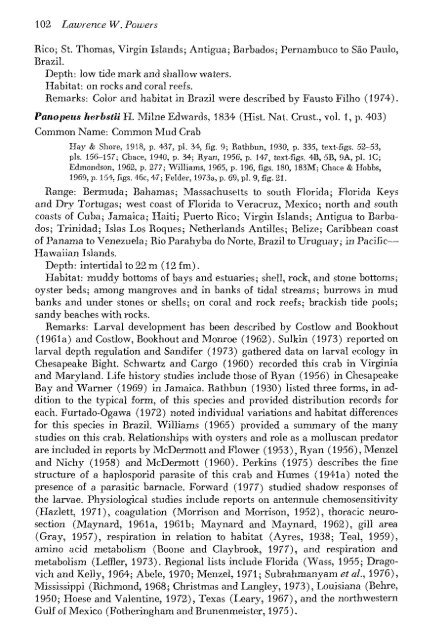You also want an ePaper? Increase the reach of your titles
YUMPU automatically turns print PDFs into web optimized ePapers that Google loves.
102 Lawrence W. Powers<br />
Rico; St. Thomas, Virgin Islands; Antigua; Barbados; Pernambuco to Sao Paulo,<br />
Brazil.<br />
Depth: low tide mark and shallow waters.<br />
Habitat: on rocks and coral reefs.<br />
Remarks: Color and habitat in Brazil were described by Fausto Filho (1974).<br />
Panopeus herbstii H. Milne Edwards, 1834 (Hist. Nat. Crust., vol. 1, p. 403)<br />
Common Name: Common Mud Crab<br />
Hay & Shore, 1918, p. 437, pi. 34, fig. 9; Rathbun, 1930, p. 335, text-figs. 52-53,<br />
pis. 156-157; Chace, 1940, p. 34; Ryan, 1956, p. 147, text-figs. 4B, 5B, 9A, pi. IC;<br />
Edmondson, 1962, p. 277; Williams, 1965, p. 196, figs. 180, 183M; Chace & Hobbs,<br />
1969, p. 154, figs. 46c, 47; Felder, 1973a, p. 69, pi. 9, fig. 21.<br />
Range: Bermuda; Bahamas; Massachusetts to south Florida; Florida Keys<br />
and Dry Tortugas; west coast of Florida to Veracruz, Mexico; north and south<br />
coasts of Cuba; Jamaica; Haiti; Puerto Rico; Virgin Islands; Antigua to Barbados;<br />
Ti'inidad; Islas Los Roques; Netherlands Antilles; Belize; Caribbean coast<br />
of Panama to Venezuela; Rio Parahyba do Norte, Brazil to Uruguay; in Pacific—<br />
Hawaiian Islands.<br />
Depth: intertidal to 22m (12 fm).<br />
Habitat: muddy bottoms of bays and estuaries; shell, rock, and stone bottoms;<br />
oyster beds; among mangroves and in banks of tidal streams; burrows in mud<br />
banks and under stones or shells; on coral and rock reefs; brackish tide pools;<br />
sandy beaches with rocks.<br />
Remarks: Larval development has been described by Costlow and Bookhout<br />
(1961a) and Costlow, Bookhout and Monroe (1962). Sulkin (1973) reported on<br />
larval depth regulation and Sandifer (1973) gathered data on larval ecology in<br />
Chesapeake Bight. Schwartz and Cargo (1960) recorded this crab in Virginia<br />
and Maryland. Life history studies include those of Ryan (1956) in Chesapeake<br />
Bay and Warner (1969) in Jamaica. Rathbun (1930) listed three forms, in addition<br />
to the typical form, of this species and provided distribution records for<br />
each. Furtado-Ogawa (1972) noted individual variations and habitat differences<br />
for this species in Brazil. Williams (1965) provided a summary of the many<br />
studies on this crab. Relationships with oysters and role as a molluscan predator<br />
are included in reports by McDermott and Flower (1953), Ryan (1956), Menzel<br />
and Nichy (1958) and McDermott (1960). Perkins (1975) describes the fine<br />
structure of a haplosporid parasite of this crab and Humes (1941a) noted the<br />
presence of a parasitic barnacle. Forward (1977) studied shadow responses of<br />
the larv'^ae. Physiological studies include reports on antennule chemosensitivity<br />
(Hazlett, 1971), coagulation (Morrison and Morrison, 1952), thoracic neurosection<br />
(Maynard, 1961a, 1961b; Maynard and Maynard, 1962), gill area<br />
(Gray, 1957), respiration in relation to habitat (Ayres, 1938; Teal, 1959),<br />
amino acid metabolism (Boone and Claybrook, 1977), and respiration and<br />
metabolism (Leffler, 1973). Regional lists include Florida (Wass, 1955; Dragovich<br />
and Kelly, 1964; Abele, 1970; Menzel, 1971; Subrahmanyam et al, 1976),<br />
Mississippi (Richmond, 1968; Christmas and Langley, 1973), Louisiana (Behre,<br />
1950; Hoese and Valentine, 1972), Texas (Leary, 1967), and the northwestern<br />
Gulf of Mexico (Fotheringham and Brunenmeister, 1975).

















